| 30 September |
• yesterday • tomorrow |
| Memorial of Saint Jerome, Priest and Doctor of the Church |
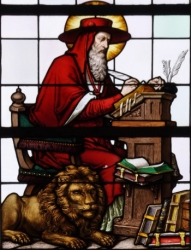
• Eusebius Hieronymus Sophronius
• Girolamo, Hieronymus, Jerom
• Man of the Bible
9 May (translation of relics)
Born to a rich pagan family, Jerome led a wild and misspent youth. Studied in Rome, Italy, and became a lawyer. He converted and joined the Church in theory, and was baptised in 365, but it was only when he began his study of theology that he had a true conversion and the faith became integral to his life.
He became a monk, then, needing isolation for his study of Scripture, he lived for years as a hermit in the Syrian deserts. There he is reported to have drawn a thorn from a lion‘s paw; the animal stayed loyally at his side for years.
Priest. Student of Saint Gregory of Nazianzen. Secretary to Pope Damasus I who commissioned Jerome to revise the Latin text of the Bible. The result was 30 years of work which we know as the Vulgate translation, the standard Latin version for over a millenia, and which is still in use today.
Friend and teacher of Saint Paula, Saint Marcella, and Saint Eustochium, an association that led to so much gossip that Jerome left Rome to return to desert solitude. He lived his last 34 years in the Holy Land as a semi-recluse, writing and translating works of history, biography, the writings of Origen, and much more. Doctor of the Church and Father of the Church. Since his own time, he has been associated in the popular mind with scrolls, writing, cataloging, translating, which led to those who work in such fields taking him as their patron – a man who knew their lives and problems.
347 at Strido, Dalmatia
• 419 of natural causes
• interred in Bethlehem
• relics at the Basilica of Saint Mary Major in Rome, Italy
• archeologists
• archivists
• Bible scholars
• librarians; libraries
• schoolchildren; students
• translators
• Saint-Jérôme, Québec, city of
• Saint-Jérôme, Québec, diocese of
• Taos Indian Pueblo
• cardinal's hat, often on the ground or behind him, indicating that he turned his back on the pomp of ecclesiastical life
• lion, referring to the who befriended him after he pulled a thorn from the creature's paw
• man beating himself in the chest with a stone
• aged monk in desert
• aged monk with Bible
• aged monk writing
• old man with a lion
• skull
• hourglass
What Jerome is ignorant of, no man has ever known. - Saint Augustine of Hippo
In the remotest part of a wild and stony desert, burnt up with the heat of the scorching sun so that it frightens even the monks that inhabit it, I seemed to myself to be in the midst of the delights and crowds of Rome. In exile and prison to which for the fear of hell I had voluntarily condemned myself, I many times imagined myself witnessing the dancing of the Roman maidens as if I had been in the midst of them: in my cold body and in my parched-up flesh, which seemed dead before its death, passion able to live. Alone with this enemy, I threw myself in spirit at the feet of Jesus, watering them with my tears, and I tamed my flesh by fasting whole weeks. I am not ashamed to disclose my temptations, but I grieve that I am not now what I then was. - Saint Jerome's letter to Saint Eustochium
The measure of our advancement in the spiritual life should be taken from the progress we make in the virtue of mortification; for it should be held as certain that the greater violence we shall do ourselves in mortification, the greater advance we shall make in perfection. - Saint Jerome
You say in your book that while we live we are able to pray for each other, but afterwards when we have died, the prayer of no person for another can be heard. But if the apostles and martyrs while still in the body can pray for others, at a time when they ought still be solicitous about themselves, how much more will they do so after their crowns, victories, and triumphs? - Saint Jerome from Against Vigilantius, 406
I interpret as I should, following the command of Christ: "Search the Scriptures," and "Seek and you shall find." For if, as Paul says, Christ is the power of God and the wisdom of God, and if the man who does not know Scripture does not know the power and wisdom of God, then ignorance of Scriptures is ignorance of Christ. No one should think that I mean to explain the entire subject matter of this great book of the prophet Isaiah in one brief sermon, since it contains all the mysteries of the lord. It prophesies that Emmanuel is to be born of a virgin and accomplish marvelous works and signs. It predicts his death, burial and resurrection from the dead as the Savior of all men. Whatever is proper to holy Scripture, whatever can be expressed in human language and understood by the human mind, is contained in the book of Isaiah. - Jerome: from a commentary on Isaiah
When the Latin Fathers are represented in a group, Saint Jerome is sometimes in a cardinal's dress and hat, although cardinals were not known until three centuries later than his time, but as the other Fathers held exalted positions in the Church, and were represented in ecclesiastical costumes, and as Saint Jerome held a dignified office in the court of Pope Dalmasius, it seemed fitting to picture him as a cardinal. The Venetian painters frequently represented him in a full scarlet robe, with a hood thrown over the head. When thus habited, his symbol was a church in his hand, emblematic of his importance to the universal Church. Saint Jerome is also seen as a penitent, or again, with a book and pen, attended by a lion. As a penitent, he is a wretched old man, scantily clothed, with a bald head and neglected beard, a most unattractive figure. When he is represented as translating the Scriptures, he is in a cell or a cave, clothed in a sombre coloured robe, and is writing, or gazing upward for inspiration. In a few instances, an angel is dictating to him. - from Saints in Art, by Clara Irskine Clement
https://catholicsaints.info/saint-jerome/
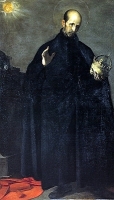
Francisco de Borja y Aragon
Born to the nobility, the great-grandson of Pope Alexander VI; grandson of King Ferdinand of Aragon; son of Duke Juan Borgia. Raised in the court of King Charles V and educated at Saragossa, Spain. Married Eleanor de Castro in 1529, and the father of eight children. Accompanied Charles on his expedition to Africa, 1535, and to Provence, 1536. Viceroy of Catalonia, 1539-1543. Duke of Gandia, 1543-1550. Widower in 1546.
Friend and advisor of Saint Ignatius of Loyola. Joined the Jesuits in 1548. Ordained in 1551. Notable preacher. Given charge of the Jesuit missions in the East and West Indies. Commissary-general of the Jesuits in Spain in 1560. General of the Jesuits in 1565. Under his generalship the Society established its missions in Florida, New Spain and Peru, and greatly developed its internal structures. Concerned that Jesuits were in danger of getting too involved in their work at the expense of their spiritual growth, he introduced their daily hour-long meditation. His changes and revitalization of the Society led to him being sometimes called the "Second Founder of the Society of Jesus". He worked with Pope Saint Pius V and Saint Charles Borromeo in the Counter-Reformation.
28 October 1510 at Gandia, Valencia, Spain
• 30 September 1572 at Ferrara, Italy
• relics translated to the Jesuit church in Madrid, Spain in 1901
20 June 1670 by Pope Clement X in Rome, Italy
• against earthquakes
• Portugal
• Rota, Marianas
skull crowned with an emperor's diadem
https://catholicsaints.info/saint-francis-borgia/
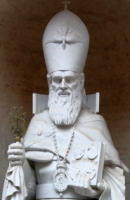
• Apostle to Armenia
• Gregorios ho phoster
• Gregory Lusavorich
• Gregory of Armenia
• Gregory the Enlightener
• Gregory, Illuminator of Armenia
• The Enlightener
Gregory's father Anak killed King Khosrov I of Armenia, and young Gregory was sent to Caesarea to avoid being killed in revenge. There he married, and was the father of two sons. Bishop of Ashtishat, Armenia where he became a hugely successful evangelist. Helped free Armenia from Persian rule. Miracle worker. Captured on his return to his native land, he was held prisoner and tortured for 13 years by the son of King Khosrov. Gregory's example led to the conversion of Khosrov to Christianity, and together they evangelized and converted most of Armenia.
257, possibly in Parthia
332 of natural causes
Armenia
https://catholicsaints.info/saint-gregory-the-illuminator/
Eldest of three children, she was orphaned as a small girl, and had to care for her brother and sister. At age 12 she took a personal of chastity. At age 20 she gave away all she owned and joined the Poor Clares, becoming a nun at the convent of Saint Urusla in Milan, Italy; her sister later became a Poor Clare nun and her brother a Franciscan friar. Abbess of the Saint Urusla convent. Abbess of a newly founded house in Pesaro, Italy, appointed by Saint Bernardine of Siena at the request of the founder, a duchess who knew of Mother Felicia’s personal holiness.
1378 in Milan, Italy
30 September 1444 in Pesaro, Piceno, Italy of natural causes
2 May 1807 by Pope Pius VII (cultus confirmation)
https://catholicsaints.info/blessed-felicia-meda/
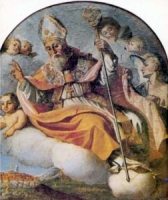
Amato di Nusco
Born to a wealthy family. First bishop of Nusco, Italy in 1048. He restored and built churches, and helped found the Benedictine monastery of Santa Maria in nearby Fondigliano, Italy, a house that lasted 400 years.
c.1003 in Nusco, Italy
• 30 September 1093 of natural causes
• miracles reported at his grave site in Nusco, Italy
• relics translated to the The Church of Saint Stephen in Nusco
https://catholicsaints.info/saint-amatus-of-nusco/
Priest. Canon of the church of Saint Lambert, the cathedral of Liège, when a young man. Cistercian monk at Villers, Belgium in 1199. Prior of Villers. Abbot of Villers in 1209. Abbot of Clairvaux in 1214. Abbot of Citeaux in 1217. General of the Cistercians. Created Cardinal Bishop of Porto and Santa Rufina by Pope Honorius III on 8 January 1219. Papal legate to France from 1220 to 1223. Ordered to suppress the Albigenses in France. Preached Crusade in Germany in from 1224 to 1226. Chosen pope at the death of Honorius III, but he declined the throne.
c.1180
1227 of natural causes
https://catholicsaints.info/blessed-conrad-of-urach/
Honorius
Benedictine monk. Missionary to England by order of Pope Gregory the Great, and at the request of Saint Augustine of Canterbury. Bishop, ordained at Lincoln, England by Saint Paulinus of York. Archbishop of Canterbury, England in 627. Ordained Saint Felix of East Anglia as bishop for the East Angles. Ordained Saint Ithamar as bishop of Rochester.
at Rome, Italy
• 653 at Canterbury, England of natural causes
• relics in Saint Peter and Paul's church, Canterbury
https://catholicsaints.info/saint-honoratus-of-canterbury/
Simone
Born to the nobility, he was raised in the court of William the Conqueror in Normandy, France. Count of Crépy, France. His family arranged two marriages for him, but Simon felt a call to religious life, gave up his title and wealth, became a monk at the Condat Abbey in the Jura Mountains, and lived for a while as a hermit. Served in the Roman Curia, and was known for his work as a peace-maker between warring factions.
• c.1082 in Rome, Italy of natural causes
• buried in Saint Peter's Basilica in Rome
https://catholicsaints.info/saint-simon-of-crepy/
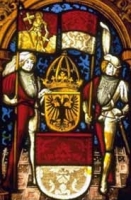
Ursus of Solothurn
22 September as one of the Martyrs of the Theban Legion
One of the Martyrs of the Theban Legion.
• beheaded c.287 in Agaunum (modern St-Maurice-en-Valais, Switzerland
• relics translated to Geneva, Switzerland in 473 by Queen Theudesinde
• relics in several churches in Switzerland
Solothurn, Switzerland
https://catholicsaints.info/saint-ursus-the-theban/
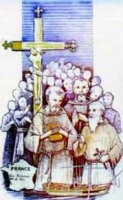
Jesuit priest. Imprisoned on a ship in the harbor of Rochefort, France and left to die during the anti-Catholic persecutions of the French Revolution. One of the Martyrs of the Hulks of Rochefort.
3 December 1710 in Saint-André, Meuse, France
30 September 1794 aboard the prison ship Washington, in Rochefort, Charente-Maritime, France
1 October 1995 by Pope John Paul II
https://catholicsaints.info/blessed-jean-nicolas-cordier/
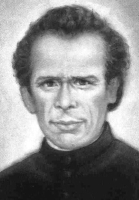
Federico, Frederico, Fredrik
Priest. Founded the Congregation of the Vincentian Sisters of Mary Immaculate (Albertines).
16 October 1820 in Turin, Italy
30 September 1876 in Lanzo Torinese, Turin, Italy
30 September 1984 by Pope John Paul II
https://catholicsaints.info/blessed-frederick-albert/

22 September as one of the Martyrs of the Theban Legion
Soldier. Martyr. One of the Martyrs of the Theban Legion.
beheaded c.287 in Agaunum (modern St-Maurice-en-Valais, Switzerland
https://catholicsaints.info/saint-victor-the-theban/
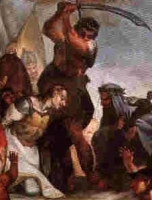
Soldier. Martyr. A vial of his blood is known to miraculously liquify. Somehow became associated the Theban Legion.
martyred near Piacenza, Italy
Piacenza, Italy
https://catholicsaints.info/saint-antoninus-of-piacenza/
Ismidón
Studied at the cathedral of Valance, France. Canon of the cathedral of Lyon, France. Bishop of Die, France in 1097. Twice made a pilgrimage to Jerusalem. Skilled negotiator and peace-maker.
Grenoble, France
1115 in Die, Gaul (in modern France)
https://catholicsaints.info/saint-ismidone-of-die/
Nun in Marseilles, Provence, France.
c.497 of natural causes
https://catholicsaints.info/saint-eusebia-of-marseilles-30-september/
Lery
Founded the monastery later known as Saint-Léry, on the River Doneff in Brittany, France.
7th-century Wales
https://catholicsaints.info/saint-laurus/
Slave-servant in the household of Julian the Apostate. Martyr.
362 in Rome, Italy
https://catholicsaints.info/saint-leopardus-the-slave/
Desiderio
Martyr.
Piacenza, Italy
https://catholicsaints.info/saint-desiderius-of-piacenza/
Lived in the 7th-century. A church in Anglesey, Wales was dedicated to him.
https://catholicsaints.info/saint-enghenedl-of-anglesey/
Nidan
Venerated in Anglesey, Wales.
c.610
https://catholicsaints.info/saint-midan-of-anglesey/
Casto
Martyr.
Piacenza, Italy
https://catholicsaints.info/saint-castus-of-piacenza/
Mentioned in some martyrologies, but no information has survived.
https://catholicsaints.info/saint-colman-of-clontibret/
An unknown number of Premonstratensian monks at the Abbey of Notre-Dame de Valsery, Picardie, France who were martyred by Calvinists.
1567 at Valsery, Pircardy, France
https://catholicsaints.info/martyrs-of-valsery-abbey/
CatholicSaints.Info Portable Edition